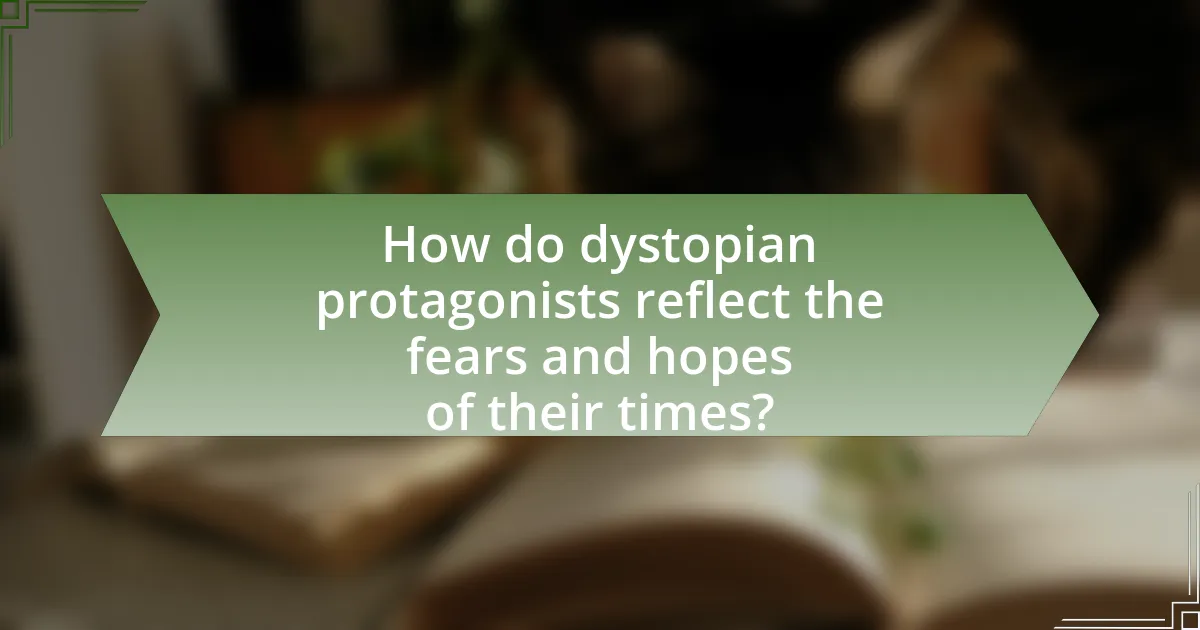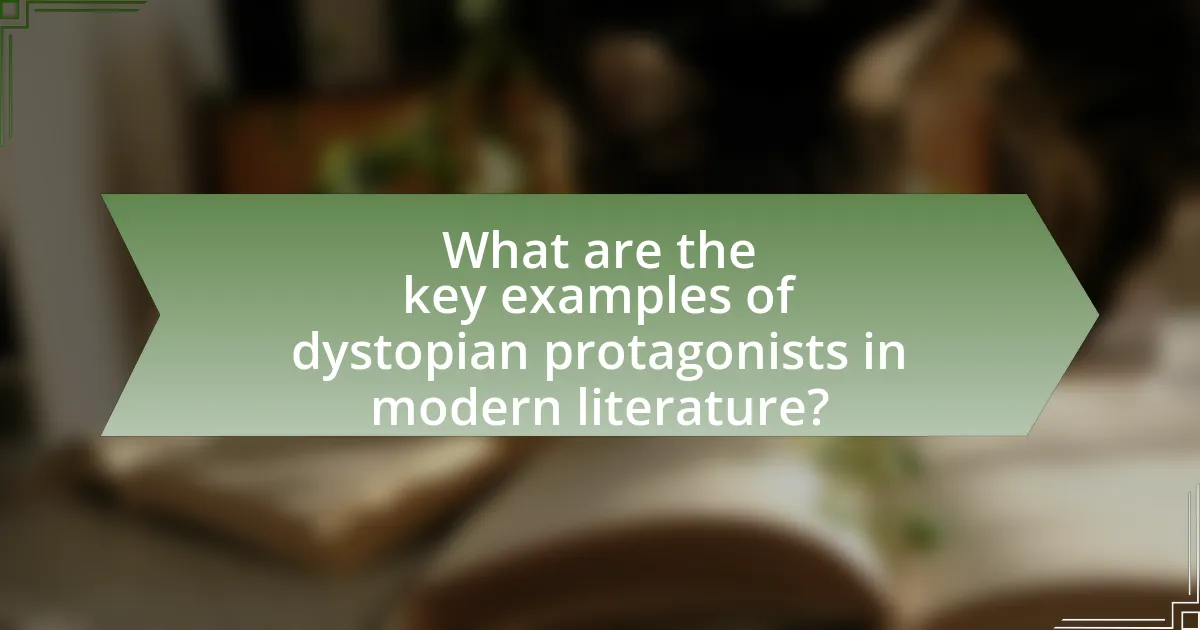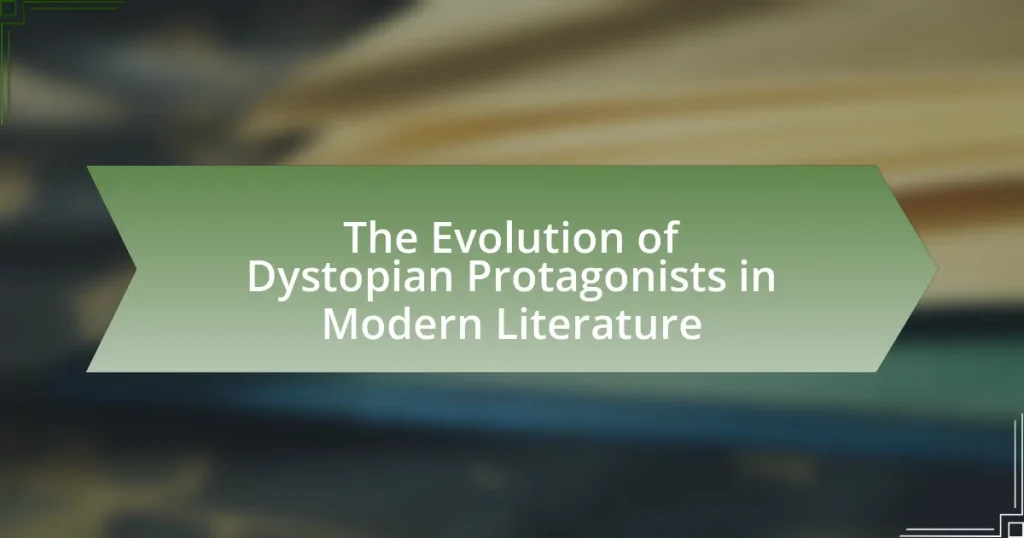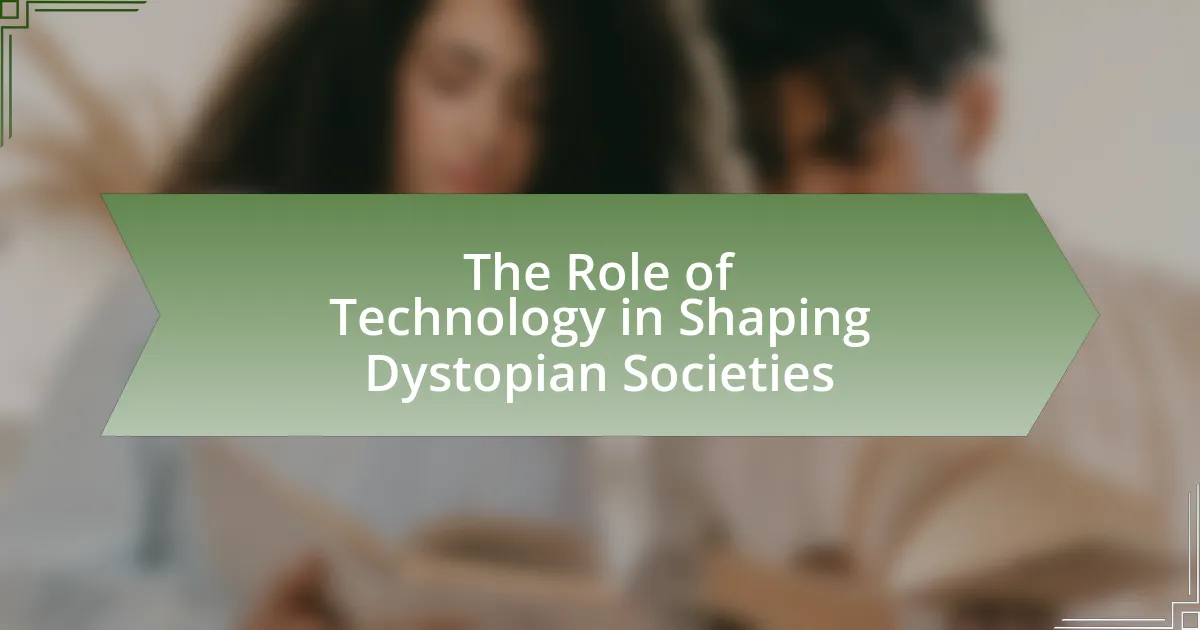The article examines the evolution of dystopian protagonists in modern literature, highlighting their increasing complexity and moral ambiguity compared to earlier archetypal heroes. It discusses how societal changes, historical events, and cultural shifts have influenced the portrayal of these characters, reflecting contemporary fears and values. Key examples include Offred from “The Handmaid’s Tale,” Winston Smith from “1984,” and Katniss Everdeen from “The Hunger Games,” each representing struggles against oppressive systems. The article also explores the psychological implications of fear on character development, the role of gender, and the impact of these protagonists on readers’ perceptions of dystopian themes.

What defines the evolution of dystopian protagonists in modern literature?
The evolution of dystopian protagonists in modern literature is defined by their increasing complexity and moral ambiguity. Unlike earlier, more archetypal heroes, contemporary protagonists often grapple with ethical dilemmas, reflecting societal anxieties about technology, governance, and identity. For instance, characters like Offred in “The Handmaid’s Tale” and Winston Smith in “1984” embody nuanced struggles against oppressive systems, showcasing personal vulnerabilities and resistance. This shift mirrors real-world concerns, as modern narratives frequently explore themes of surveillance, environmental collapse, and authoritarianism, making protagonists relatable and reflective of contemporary societal issues.
How have societal changes influenced the portrayal of dystopian protagonists?
Societal changes have significantly influenced the portrayal of dystopian protagonists by reflecting contemporary fears and values. For instance, the rise of technology and surveillance in modern society has led to protagonists who often grapple with issues of privacy and autonomy, as seen in works like “1984” by George Orwell and “The Circle” by Dave Eggers. Additionally, increasing awareness of social justice issues has resulted in protagonists who embody marginalized voices, such as in “The Hunger Games” by Suzanne Collins, where Katniss Everdeen represents resistance against oppressive systems. These portrayals serve as mirrors to societal anxieties, illustrating how dystopian narratives evolve in response to the changing landscape of human experience and cultural discourse.
What historical events have shaped the characteristics of these protagonists?
Historical events such as World War II, the Cold War, and the rise of totalitarian regimes have significantly shaped the characteristics of dystopian protagonists. For instance, World War II exposed the horrors of authoritarianism and genocide, influencing authors like George Orwell, whose protagonist in “1984” embodies the struggle against oppressive surveillance and control. The Cold War era fostered themes of paranoia and distrust, evident in characters like those in “Fahrenheit 451” by Ray Bradbury, who confront censorship and the loss of individuality. Additionally, the emergence of totalitarian regimes in the 20th century, such as Stalin’s Soviet Union, has led to protagonists who resist oppressive governments, reflecting the real-life struggles against tyranny and the quest for freedom. These historical contexts provide a foundation for understanding the motivations and traits of modern dystopian protagonists.
How do cultural shifts impact the motivations of dystopian protagonists?
Cultural shifts significantly influence the motivations of dystopian protagonists by altering their values, beliefs, and responses to societal challenges. For instance, as societal norms evolve, protagonists often reflect contemporary issues such as inequality, environmental concerns, or authoritarianism, driving them to resist oppressive systems. A clear example is found in works like “The Hunger Games” by Suzanne Collins, where the protagonist Katniss Everdeen’s motivations are shaped by a culture that emphasizes survival and rebellion against a corrupt government, mirroring real-world discussions about class disparity and media manipulation. This alignment with cultural contexts not only enhances character depth but also resonates with readers, making the protagonists’ struggles more relatable and urgent.
What are the common traits of dystopian protagonists throughout different eras?
Dystopian protagonists across different eras commonly exhibit traits such as resilience, moral complexity, and a quest for truth. Resilience is evident as these characters often endure oppressive regimes or catastrophic environments, showcasing their ability to survive and adapt. For instance, Winston Smith in George Orwell’s “1984” embodies resilience as he navigates a totalitarian state. Moral complexity is another defining trait, as protagonists frequently grapple with ethical dilemmas, reflecting the nuanced nature of their societies. Katniss Everdeen from “The Hunger Games” series illustrates this complexity through her choices that balance survival and rebellion. Lastly, the quest for truth drives many dystopian protagonists, as they seek to uncover hidden realities about their world, exemplified by Offred in Margaret Atwood’s “The Handmaid’s Tale,” who strives to understand her oppressive circumstances. These traits collectively highlight the evolution of dystopian protagonists as they respond to the challenges posed by their respective societies.
How do the traits of early dystopian protagonists compare to contemporary ones?
Early dystopian protagonists often exhibit traits of conformity, helplessness, and a strong sense of individualism in the face of oppressive systems, while contemporary protagonists tend to display resilience, agency, and a focus on collective action. For instance, characters like Winston Smith in George Orwell’s “1984” embody a struggle against totalitarian control, reflecting a sense of isolation and despair. In contrast, modern protagonists, such as Katniss Everdeen in Suzanne Collins’ “The Hunger Games,” demonstrate proactive resistance and leadership, often mobilizing others to challenge oppressive regimes. This shift illustrates a broader narrative evolution from individual struggle to collective empowerment in dystopian literature.
What role does gender play in the evolution of these characters?
Gender plays a significant role in the evolution of dystopian protagonists by shaping their identities, motivations, and societal roles. In modern literature, female protagonists often challenge traditional gender norms, showcasing resilience and agency in oppressive environments, as seen in works like “The Hunger Games” by Suzanne Collins, where Katniss Everdeen embodies strength and defiance against a patriarchal system. Conversely, male protagonists frequently grapple with expectations of masculinity, which can lead to internal conflict and vulnerability, as illustrated in “1984” by George Orwell, where Winston Smith’s struggle against a totalitarian regime reflects the pressures of male identity. These gender dynamics not only influence character development but also reflect broader societal issues, highlighting how gender informs the narrative and thematic depth of dystopian literature.

How do dystopian protagonists reflect the fears and hopes of their times?
Dystopian protagonists reflect the fears and hopes of their times by embodying societal anxieties and aspirations in response to contemporary issues. For instance, characters in George Orwell’s “1984” illustrate fears of totalitarianism and surveillance, mirroring post-World War II concerns about government overreach and loss of individual freedoms. Conversely, protagonists in works like “The Hunger Games” by Suzanne Collins represent hope and resilience against oppressive systems, resonating with modern themes of social justice and activism. These characters serve as a lens through which readers can explore the complexities of their own societal contexts, making them relevant to the fears and hopes prevalent during their creation.
What fears are commonly represented through dystopian protagonists?
Dystopian protagonists commonly represent fears of totalitarianism, loss of individuality, environmental collapse, and technological control. These characters often embody the struggle against oppressive regimes that suppress freedom and autonomy, reflecting societal anxieties about government overreach and surveillance, as seen in works like George Orwell’s “1984.” Additionally, fears surrounding environmental degradation are illustrated through protagonists in narratives such as “The Road” by Cormac McCarthy, where survival in a post-apocalyptic world highlights the consequences of ecological neglect. Furthermore, the fear of technology’s dominance is evident in stories like “Neuromancer” by William Gibson, where characters grapple with the implications of artificial intelligence and cybernetic enhancements. These themes resonate with contemporary concerns, making dystopian protagonists a mirror of societal fears.
How do these fears manifest in the actions and decisions of the protagonists?
Fears manifest in the actions and decisions of protagonists through avoidance, rebellion, and self-sacrifice. For instance, protagonists often avoid situations that trigger their fears, leading to isolation or inaction, as seen in characters who refuse to confront oppressive regimes. Additionally, rebellion against authority figures or societal norms frequently arises from deep-seated fears of loss of freedom or identity, prompting characters to take drastic measures to assert their autonomy. Self-sacrifice is another common manifestation, where protagonists make choices that endanger their own safety to protect others, reflecting fears of helplessness or moral failure. These actions are evident in modern dystopian literature, where characters navigate complex emotional landscapes shaped by their fears, ultimately driving the narrative forward.
What are the psychological implications of these fears on character development?
Fears significantly influence character development by shaping motivations, behaviors, and emotional responses. In dystopian literature, protagonists often confront fears such as loss of autonomy, societal collapse, or existential threats, which drive their actions and decisions. For instance, characters like Katniss Everdeen in “The Hunger Games” exhibit resilience and resourcefulness as a direct response to their fears of oppression and survival. This psychological response not only deepens their character but also reflects broader themes of resistance and hope in oppressive environments. Research indicates that fear can lead to heightened emotional complexity, allowing characters to evolve through their struggles, as seen in works like “1984” by George Orwell, where Winston Smith’s fear of totalitarian control leads to his internal conflict and ultimate rebellion.
In what ways do dystopian protagonists embody hope or resistance?
Dystopian protagonists embody hope or resistance primarily through their actions and beliefs that challenge oppressive systems. These characters often display resilience in the face of adversity, motivating others to question the status quo and seek change. For instance, in “The Hunger Games,” Katniss Everdeen symbolizes hope by becoming a figure of rebellion against the totalitarian regime, inspiring others to rise up. Similarly, in “1984,” Winston Smith’s quest for truth and individuality represents a form of resistance against the pervasive control of the Party, highlighting the human spirit’s desire for freedom. These narratives illustrate that even in bleak circumstances, protagonists can ignite hope and foster collective resistance, demonstrating the enduring power of individual agency in dystopian settings.
How do these characters inspire change within their narratives?
Dystopian protagonists inspire change within their narratives by challenging oppressive systems and advocating for individual freedom. For instance, characters like Katniss Everdeen in “The Hunger Games” and Offred in “The Handmaid’s Tale” confront authoritarian regimes, sparking rebellion and raising awareness about societal injustices. Their actions often lead to collective movements, as seen when Katniss becomes a symbol of resistance, motivating others to join the fight against tyranny. This dynamic illustrates how their personal struggles and moral choices catalyze broader societal transformations, emphasizing the power of individual agency in the face of systemic oppression.
What are the consequences of hope in dystopian settings for protagonists?
Hope in dystopian settings often leads protagonists to experience both resilience and vulnerability. This duality manifests as hope drives characters to challenge oppressive systems, fostering a sense of agency and motivation to seek change. However, this same hope can also result in disillusionment when faced with harsh realities, leading to emotional turmoil or despair. For instance, in George Orwell’s “1984,” Winston Smith’s hope for rebellion ultimately leads to his psychological breakdown when confronted with the Party’s unyielding power. Thus, while hope can empower protagonists to resist and envision a better future, it also exposes them to profound risks of disappointment and suffering.

What are the key examples of dystopian protagonists in modern literature?
Key examples of dystopian protagonists in modern literature include Offred from “The Handmaid’s Tale” by Margaret Atwood, Winston Smith from “1984” by George Orwell, and Katniss Everdeen from “The Hunger Games” series by Suzanne Collins. Offred represents the struggle against a totalitarian regime that subjugates women, highlighting themes of oppression and resistance. Winston Smith embodies the fight against pervasive surveillance and thought control, illustrating the dangers of authoritarianism. Katniss Everdeen serves as a symbol of rebellion against an oppressive government that exploits its citizens, showcasing the power of individual agency in the face of systemic injustice. These characters reflect the complexities of human resilience and the moral dilemmas faced in dystopian societies.
Which novels feature iconic dystopian protagonists and why are they significant?
Novels that feature iconic dystopian protagonists include “1984” by George Orwell, “Fahrenheit 451” by Ray Bradbury, and “The Handmaid’s Tale” by Margaret Atwood. These protagonists are significant because they embody the struggle against oppressive regimes and highlight the consequences of totalitarianism, censorship, and gender oppression. For instance, Winston Smith in “1984” represents the fight for individuality in a society that suppresses free thought, while Guy Montag in “Fahrenheit 451” symbolizes the awakening of consciousness in a world that bans books. Offred in “The Handmaid’s Tale” illustrates the extreme subjugation of women, serving as a cautionary tale about the potential for societal regression. Each character’s journey reflects broader themes of resistance and the human spirit’s resilience against dehumanization.
What makes characters like Winston Smith or Offred memorable in their narratives?
Characters like Winston Smith from “1984” and Offred from “The Handmaid’s Tale” are memorable due to their profound internal struggles against oppressive regimes, which resonate with readers on a personal level. Winston’s quest for truth and individuality in a totalitarian society highlights the human desire for freedom, while Offred’s experiences of subjugation and her longing for autonomy reflect the impact of patriarchal control. Both characters embody the fight against dehumanization, making their narratives compelling and relatable. Their emotional depth and moral dilemmas serve as powerful reminders of the consequences of societal oppression, ensuring their lasting impact in the realm of dystopian literature.
How do these characters influence readers’ perceptions of dystopian themes?
Characters in dystopian literature significantly shape readers’ perceptions of dystopian themes by embodying the struggles and moral dilemmas inherent in oppressive societies. For instance, protagonists often face choices that highlight the consequences of totalitarianism, surveillance, and loss of individuality, prompting readers to reflect on the implications of such themes in their own lives. In George Orwell’s “1984,” Winston Smith’s rebellion against a repressive regime illustrates the dangers of conformity and the erosion of personal freedom, which resonates with contemporary concerns about privacy and government overreach. Similarly, in Margaret Atwood’s “The Handmaid’s Tale,” Offred’s experiences as a subjugated woman in a theocratic society challenge readers to consider gender roles and autonomy, making the themes of oppression and resistance more relatable and urgent. These characters serve as conduits for exploring complex societal issues, ultimately influencing how readers interpret and engage with dystopian narratives.
How do contemporary authors innovate the concept of dystopian protagonists?
Contemporary authors innovate the concept of dystopian protagonists by creating complex, multifaceted characters who often challenge traditional hero archetypes. These protagonists frequently embody moral ambiguity, showcasing flaws and vulnerabilities that reflect real human experiences in oppressive societies. For instance, in works like “The Hunger Games” by Suzanne Collins, Katniss Everdeen is portrayed not only as a reluctant hero but also as a survivor grappling with the consequences of her actions, which adds depth to her character. Additionally, authors like N.K. Jemisin in “The Broken Earth” trilogy present protagonists who navigate systemic oppression and personal trauma, emphasizing themes of resilience and identity. This shift towards nuanced character development allows readers to engage with dystopian narratives on a more personal level, reflecting contemporary societal issues and the complexities of human nature.
What new archetypes are emerging in modern dystopian literature?
New archetypes emerging in modern dystopian literature include the reluctant hero, the morally ambiguous leader, and the tech-savvy rebel. The reluctant hero often grapples with personal doubts and societal expectations, reflecting contemporary themes of anxiety and disillusionment. The morally ambiguous leader challenges traditional notions of good and evil, showcasing the complexities of power and survival in oppressive regimes. The tech-savvy rebel embodies the intersection of technology and resistance, highlighting the role of digital tools in modern activism. These archetypes reflect current societal issues, such as the impact of technology on identity and the ethical dilemmas faced in authoritarian contexts.
How do these innovations reflect current societal issues?
Innovations in modern literature, particularly in the portrayal of dystopian protagonists, reflect current societal issues such as surveillance, inequality, and environmental degradation. For instance, characters often embody the struggles against oppressive regimes that utilize technology for control, mirroring real-world concerns about privacy and government overreach, as seen in George Orwell’s “1984” and more contemporary works like “The Hunger Games” by Suzanne Collins. These narratives highlight the growing anxiety over social justice and economic disparity, as protagonists frequently emerge from marginalized backgrounds, emphasizing the fight against systemic oppression. Furthermore, the depiction of environmental collapse in works like “The Water Knife” by Paolo Bacigalupi underscores the urgent issues of climate change and resource scarcity, resonating with ongoing global discussions about sustainability and ecological responsibility.
What lessons can be learned from the evolution of dystopian protagonists?
The evolution of dystopian protagonists teaches that resilience and moral complexity are essential traits in the face of oppressive systems. Historically, characters like Winston Smith in George Orwell’s “1984” illustrate the struggle against totalitarianism, while Katniss Everdeen in Suzanne Collins’ “The Hunger Games” embodies rebellion and personal sacrifice. These protagonists reflect societal fears and aspirations, showing that individuals can challenge authority and inspire change. The shift from passive to active resistance in these characters highlights the importance of agency and the moral dilemmas faced in dystopian settings, emphasizing that personal choices can have significant impacts on broader societal issues.
How can readers apply insights from these characters to real-world challenges?
Readers can apply insights from dystopian protagonists to real-world challenges by analyzing their resilience and moral dilemmas in oppressive environments. These characters often face significant adversity, which can inspire readers to confront their own challenges with determination and ethical considerations. For instance, Katniss Everdeen from “The Hunger Games” demonstrates the importance of standing up against injustice, encouraging readers to advocate for social change in their communities. Additionally, Winston Smith in “1984” illustrates the dangers of totalitarianism, prompting readers to remain vigilant about their freedoms and question authority. Such narratives provide valuable lessons on courage, critical thinking, and the necessity of collective action in the face of societal issues.
What best practices can writers follow when creating dystopian protagonists?
Writers can create compelling dystopian protagonists by ensuring they possess relatable motivations and flaws. Relatable motivations allow readers to connect with the character’s struggles against oppressive systems, while flaws make them more human and believable. For instance, characters like Katniss Everdeen from “The Hunger Games” exhibit both resilience and vulnerability, which enhances their depth. Additionally, writers should place their protagonists in morally complex situations that challenge their beliefs, as seen in “1984” with Winston Smith, who grapples with the consequences of rebellion. This complexity not only drives the narrative but also reflects the nuanced realities of living in a dystopian society.




